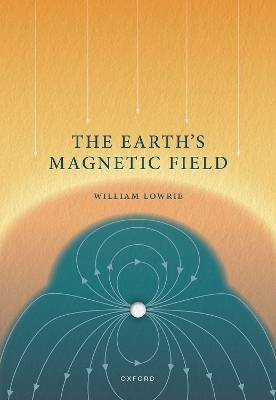
The Earth's Magnetic Field
Oxford University Press (Verlag)
978-0-19-286267-9 (ISBN)
The Earth's magnetic field has existed for hundreds of millions of years, far longer than life has existed on Earth, and affects our lives in many ways. We can use it to orient buildings and navigate across unmarked territory. Moreover, it protects us from harmful radiation from space.
Intended as an introductory guide for non-specialist readers, this book describes the historical importance of the Earth's magnetic field and its role in protecting the planet from harmful high-energy radiation from the Sun. With explanations of underlying physics of processes and references to original scientific works, the reader can explore the Earth's magnetic field and the various ways in which geomagnetics are used and measured, including the analysis of modern satellite-based investigations and the effects of solar activity on the geomagnetic field.
William Lowrie earned a B.Sc. at the University of Edinburgh in 1960, an M.A. at the University of Toronto in 1962 and a Ph.D. at the University of Pittsburgh in 1967. He held research positions with Gulf Oil Company and Lamont Doherty Geological Observatory. He has authored 130 scientific articles and five books, including the textbook Fundamentals of Geophysics. He is Fellow of AGU, Member of the Academia Europaea, and in 2022 was awarded the Arthur Holmes Medal of the European Geosciences Union.
1: What is magnetism?
1.1 The discovery of magnetism
1.2 The Earth as a magnet
1.3 The origin of magnetic fields
1.4 Electrical currents and magnetic fields
1.5 Magnetism at atomic level: the Bohr model of the atom
1.6 Spectral analysis and the Zeeman effect
1.7 Electromagnetism
1.8 Particle radiation
2: How the geomagnetic field is measured
2.1 Measurement of magnetic field direction
2.2 Measurement of magnetic field intensity
2.3 Vector magnetometers
2.4 Scalar magnetometers
2.5 Magnetic gradiometers
2.6 Terrestrial magnetic surveying
2.7 Magnetic observatories
2.8 Satellite mapping of the global magnetic field
2.9 The geomagnetic field at the Earth's surface
3: Sources of the Earth's magnetic field
3.1 The Earth's internal structure
3.2 Pressure and temperature in the Earth
3.3 Dipole and multipole fields
3.4 Internal and external sources of the magnetic field
3.5 Spherical harmonic analysis of the internal field
3.6 The international geomagnetic reference field
3.7 Spatial power spectrum of the internal field
3.8 The lithospheric magnetic field
4: The geomagnetic dynamo
4.1 The concept of a self-sustaining dynamo
4.2 Heat transport in the core
4.3 The Coriolis force due to the Earth's rotation
4.4 Magnetohydrodynamics and the frozen-flux concept
4.5 The dynamo model for the origin of the internal magnetic field
4.6 The magnetic influence of the inner core
4.7 The magnetic field at the core-mantle boundary
4.8 Archeomagnetic secular variation of paleointensity
4.9 The geomagnetic field in the early Earth
5: The magnetism of the Earth's Crust
5.1 Physical properties of the crust and mantle
5.2 Crystal rock types
5.3 Types of magnetism in minerals
5.4 Antiferromagnetic and ferrimagnetic minerals
5.5 Induced and remanent magnetizations
5.6 The thickness of the magnetized crustal layer
5.7 How a magnetic anomaly originates
5.8 Continental magnetic anomalies
5.9 The magnetization of the oceanic crust
5.10 The age of the ocean floor
6: The ancient geomagnetic field
6.1 The natural remanent magnetizations of rocks
6.2 The geocentric axial dipole hypothesis
6.3 Methods of paleomagnetism
6.4 Apparent polar wander and continental reconstructions
6.5 Geomagnetic polarity reversals
6.6 Magnetic polarity stratigraphy
6.7 Geomagnetic polarity in the Early Mesozoic and Paleozoic
6.8 The geomagnetic field in the Precambrian
7: The effects of solar activity on the geomagnetic field
7.1 The internal structure of the Sun
7.2 Energy transfer in the Sun
7.3 Sunspots and the solar cycle
7.4 The Sun's magnetic field
7.5 The solar wind
7.6 The interplanetary magnetic field
7.7 Coronal mass ejections and solar flares
8: The magnetosphere and ionosphere
8.1 The magnetosphere
8.2 The Van Allen radiation belts
8.3 The ionosphere
8.4 Electromagnetic induction in the crust and mantle
8.5 Magnetic storms and substorms
8.6 Space weather
Free
| Erscheinungsdatum | 10.07.2023 |
|---|---|
| Zusatzinfo | 61 line drawings and 8 colour photographs |
| Verlagsort | Oxford |
| Sprache | englisch |
| Maße | 171 x 252 mm |
| Gewicht | 508 g |
| Themenwelt | Naturwissenschaften ► Geowissenschaften ► Geophysik |
| Naturwissenschaften ► Physik / Astronomie ► Angewandte Physik | |
| Naturwissenschaften ► Physik / Astronomie ► Elektrodynamik | |
| ISBN-10 | 0-19-286267-7 / 0192862677 |
| ISBN-13 | 978-0-19-286267-9 / 9780192862679 |
| Zustand | Neuware |
| Haben Sie eine Frage zum Produkt? |
aus dem Bereich


